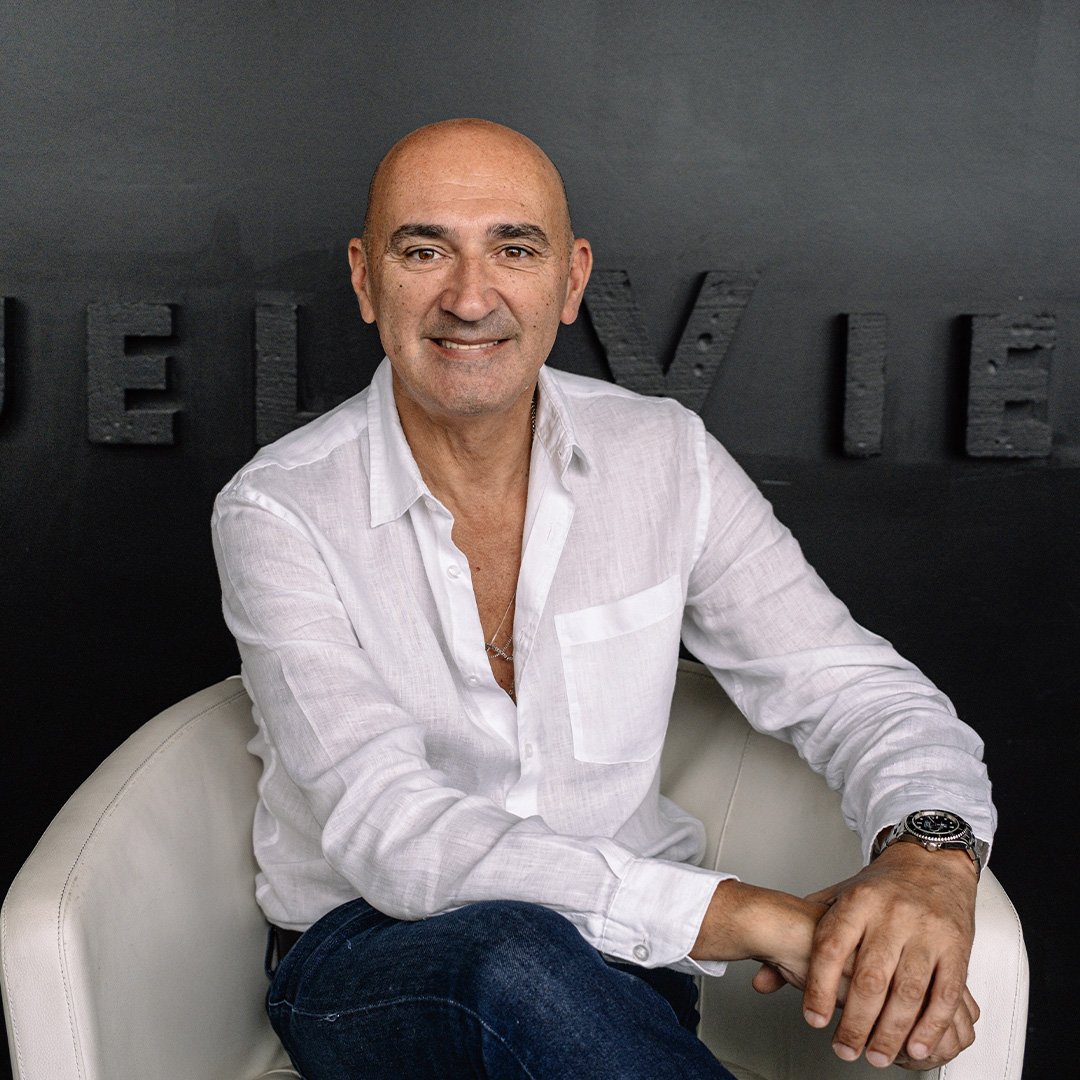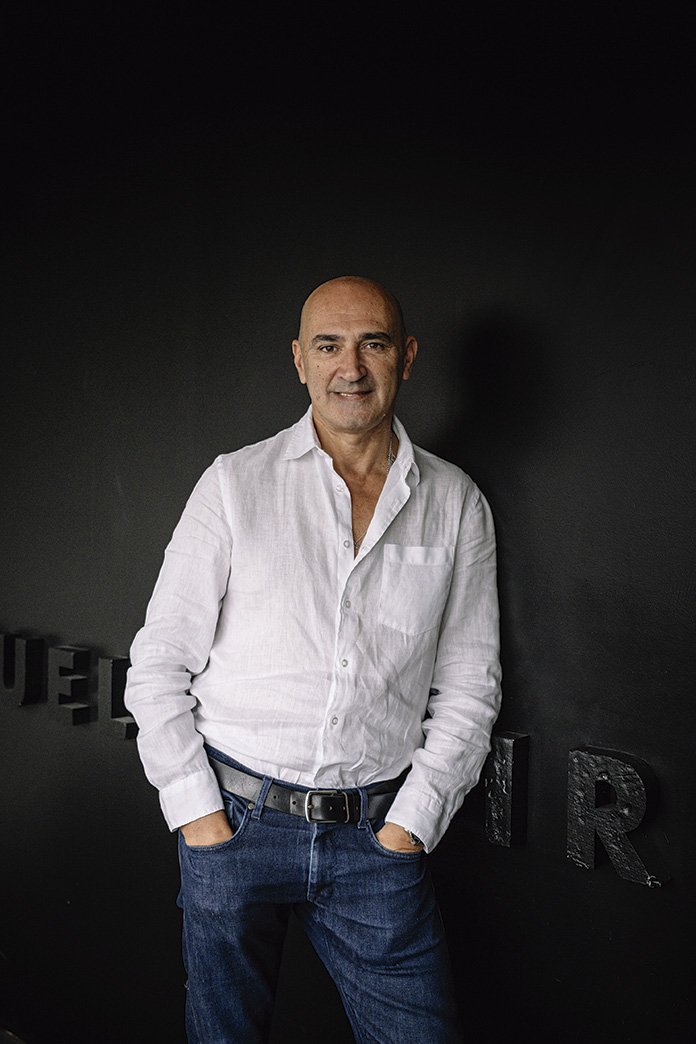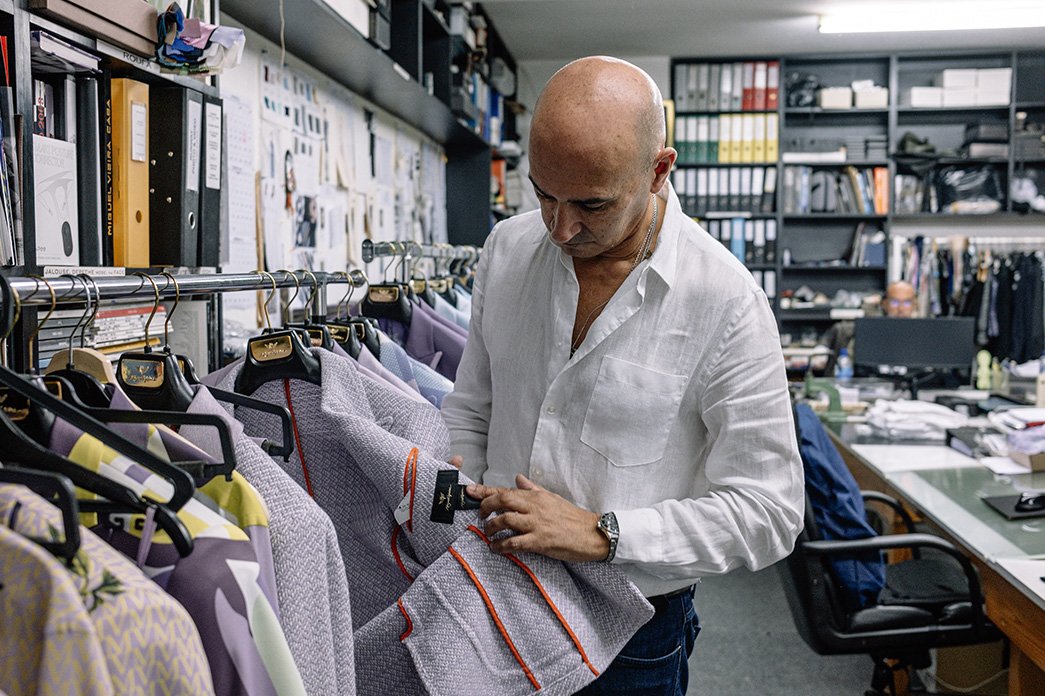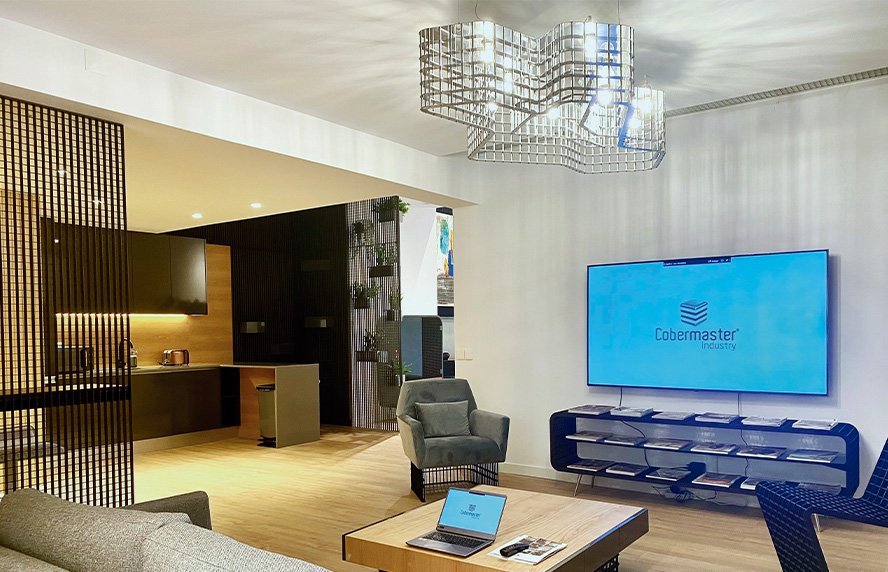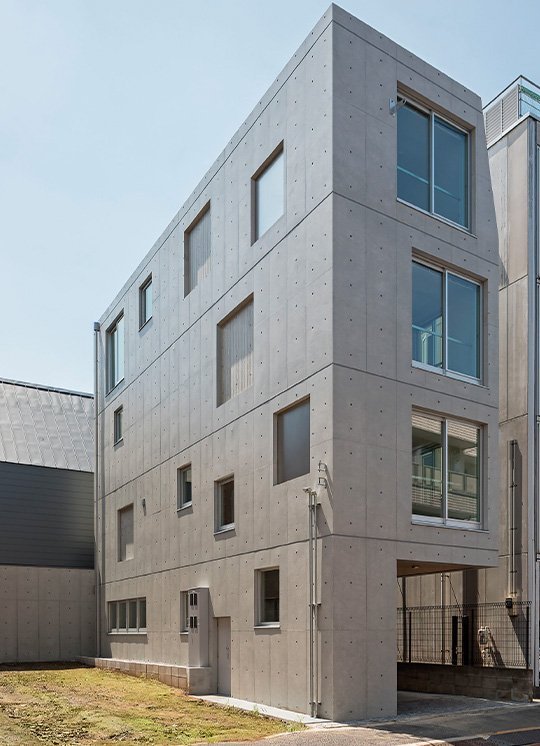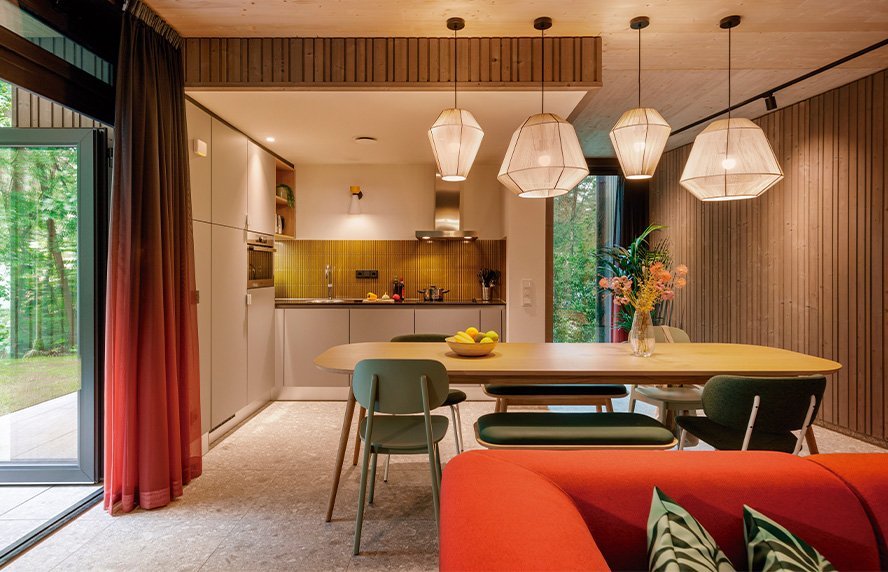In three adjectives, how would you characterise today’s Miguel Vieira?
I think I’m a good friend, a perfectionist and a very methodical man.
Tell us about how your passion for fashion came about.
It came out of nowhere, completely. Generally, most designers would play with dolls and so on, but I was a kid who didn’t care much for fashion, who wore what his mother made him wear. I always wore shorts. It was like that for a long time. Meanwhile, I decided to take a course in Quality Control, which allowed for various specialisations. I chose the textile branch. At the same time, as I had a certain knack for drawing buildings, I was thinking of taking up architecture. For me, drawing and talking were very close. Often, it was actually easier to communicate by drawing than by verbalising. Then I was invited to work in a clothing company, mainly to deal with quality control, but it was there that I developed a taste for fashion and, one or two years later, I launched Miguel Vieira.
So, you developed Miguel Vieira in 1988. How would you characterise the brand’s DNA?
Over time, I have tried to find some details that would very quickly and easily allow people to identify what Miguel Vieira is. One of the first details was the signature, in which the brand name is explicit. Then, I managed to create a logo, in the shape of two wings, which is immediately associated with Miguel Vieira. Another detail was the choice of a colour, namely black. These are the details that are slowly built up so that, sooner or later, the brand can be perfectly identified. A typical detail of Miguel Vieira is that the models wear a wedding ring in all the fashion shows. A detail that is very nice for the models. It’s a marriage between the model and the brand, presenting them as a member of the team.
Do you feel that the emergence of the pandemic represented a pivotal period in the luxury brand’ s evolution?
For me, it was a wonderful time in my life, because I was able to rest, something I hadn't done for a long time. I was able to stop and have time for myself. I took the opportunity to think and rethink the brand. Did I sell a lot? No, I didn’t. A lot of people say the opposite, that they sold a lot. Personally, I don’t see anyone wanting to buy a suit to be at home, or high heels to walk around at home...
So, the financial and sales side, during the pandemic, was very complicated. We had to rethink, in particular, the online side of things. I was the first person to have a website and an app in Portugal. In the meantime, I was invited many times to sell online, but never did, because I didn’t want to upset my physical store customers. So, the pandemic was the moment in which I invested in online, as my own customers were also starting to focus on it.
How would you describe your creative process, from idea to creation?
It’s an extensive process, over many months. It’s six months that often flow into a year or two, because I’m a good observer. I gather a lot of photographs in my mind, as much of journeys and people I see, as of the table laid in the restaurant. They are photographs that stay with me. And when the time comes to think about a theme for developing the new collection, I pass the information on to paper, holding a briefing with the whole team so that we can focus on the theme. Let’s imagine, now, that the content of the collection has to do with a certain film. I get my team to go to libraries to look up the people’s biographies, to search on the Internet and go to the cinema to see the film. All to retain as many details as possible and develop the collection.
The selection of raw materials is made well in advance, 99% of which are Italian. I go to a highly select fair, where you can find the top fabrics of international brands, such as Loro Piana, Zegna, among others... To give you an idea, I’ve already made these purchases for 2024. Then, there’s the process of organising the patterns, arranging the silhouettes, etc. The last thing is the process of putting on a fashion show.
Which materials do you most like to work with? Do you use an Portuguese raw materials?
1% of the materials I use are Portuguese. Very few. I use Portuguese woollens, but over time, many of them have disappeared. I am very used to working with the fabric brands that I mentioned before. I like good quality materials. It makes a difference, because the sewing is different, the way you assemble a shoe is different... So, I try not to deviate from that direction and never lower the quality in terms of raw materials.
Is your brand aimed at all types of people and sizes?
Yes, the collection is made in the standard size for models. It’s 48 for men and 36 for women, in terms of the catwalk. I think the show is a spectacle and as such, people want to see elegant, slim models. I’m not against bigger people, however, I like working this way more. Obviously, each piece is scaled up to the maximum size. The clothes, for example, are up to 60 and the shoes are up to 46.
"… it is very complicated to make a collection that is 100% sustainable from head to toe”
There is a lot of talk about sustainability in fashion these days. Have you made this a maxim?
I took part in drawing up the government’s programme on sustainability, two terms of office ago. I have always given a lot of importance to sustainability.
What sustainable innovations can we expect from Miguel Vieira?
I have increasingly found products abroad that combine several environmentally friendly features. Between a sustainable product and a non-sustainable one, I always choose the sustainability side. Now, it is very complicated to make a collection that is 100% sustainable from head to toe.
So, sustainability is still a challenge?
Yes, it is a challenge. There is not that much out there, in that sense. A given sustainable product may exist, but the necessary number of suppliers to meet the demand is not there. I may want a sustainable shoelace, and I see the complicated situation to get it. The same goes for a zip, button, lining of a jacket... There are things that are hard to get. But, yes, the team at my studio is formatted so that everything is more and more sustainable.
Where do you find your inspiration?
Talking to you, talking to the cameraman, having dinner with friends, travelling... I spend a lot of time away. All sources of inspiration are important. Often sitting on a park bench, watching people walking by, inspires me. It’s watching and learning about street fashion, which is very important. Then I transform it into something more luxurious, through its details.
You have been able to say "no” to Prada and other luxury brands. Have you ever regretted the sacrifices you made to make your dream of creating your own brand come true?
I haven’t regretted it, but I can say it’s a very difficult journey. All professions are complicated. A doctor, to become a doctor, has had to make many sacrifices, studying for many years. Here, in the fashion world, it’s the same.
In Portugal, the factories often work almost 100% for abroad. They make a collection and go abroad, not to sell their own product, but for other brands to come to them, saying what they like or don’t like, and then the factory removes its label and makes the pieces that the brand in question dictates. That was never my goal. If I had gone down that road, I would have many cars and many houses by now, just like many manufacturers. I always thought it was very important that Portugal, as it isn’t a country with a fashion tradition, to have people who could embellish the country with their own creations. When I present my collections at an international fair and a top brand arrives pointing out the pieces it likes the most, asking to remove the Miguel Vieira label and put on their own, I simply say "the door you came in through is the door you can leave through”. So, if I had followed another path, I could have been a millionaire, but I am happy with what I do today, with my brand. I still have a long way to go to achieve all my goals, but I think, in the short term, things could take a big leap forward.
What was the moment when you realised that not only the brand, but your name had started to grow?
Contrary to what everyone thinks, I didn’t start by producing shoes. I started with a collection of women’s clothes and, much later, I launched shoes. I made several collections and only later did I organise the fashion shows. I’ll explain why: for example, it wouldn’t make sense for Prada to have a fashion show in which the models wore Gucci bags, Louis Vuitton shoes, Brioni belts and Chanel make-up. So, it’s logical that Prada, in its own fashion show, has the woman and the man dressed by the brand from head to toe. That was always my goal, to dress the model with my own brand’s glasses, the same goes for jewellery, shoes, belts, bags... That’s why I had a period not of celibacy, but a time dedicated to the organisation of the collections, in order to be able to present a complete look. Whether the person likes it or not, it’s all Miguel Vieira products, and I think the leap is made when you start doing fashion shows.
Following the success of my fashion shows, things began to evolve, even in Portugal. People began to like it, to associate the brand with my name, and invitations to many events began to arrive. And then there’s a journey that’s more like a desert, because it never ends. We have many people in the country, from various fields, who think they are superstars, but they are only stars in Portugal, where we are 9 or 10 million inhabitants. These people then arrive in Vigo and nobody knows who they are. So, making a name for yourself in Portugal isn’t complicated, but it is difficult to get to a Fashion Week in Paris or New York and be interviewed by the big international magazines. Being recognised abroad is complicated and, for me, having visibility also implies that it’s not only in Portugal, but also on the international stage.
What are the requirements that a fashion designer has to have to conquer the international stage?
First of all, there’s a new generation and I, in fact, haven’t had access to it. It is a generation that has Instagram, Facebook, TikTok and a thousand and one things that, at the time I started, I didn’t have. Today, everything is just a click away and things are much easier. However, this is a new generation that thinks anything is possible when you click on an app. A lot of the time, people have to give up their mobile phones or computers because, when you’re in a couture business, and there’s a thread that has to travel a huge journey, you have to be prepared for it to break, and then it won’t be an app that will make it go all the way to the needle. I think there is a new generation that thinks that, to be a fashion designer or creator, all you need is a computer that makes it all easy. You also have to pick up scissors and cut, know how to improvise in unexpected situations... and there are people who don’t know how to do that. I really value that more practical part of doing things.
"We don't have Portuguese brands represented abroad”
